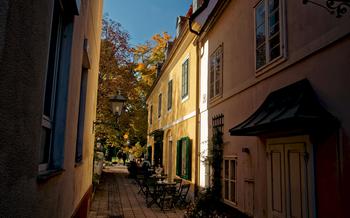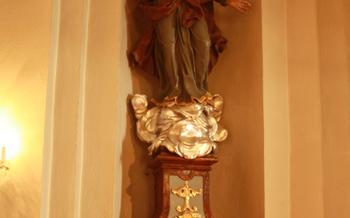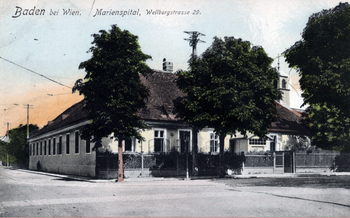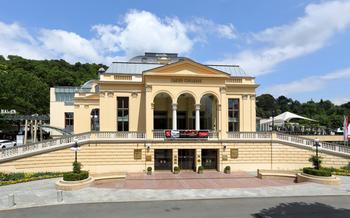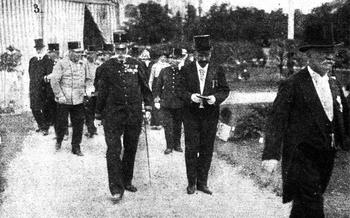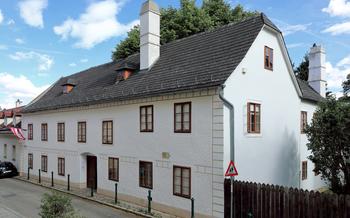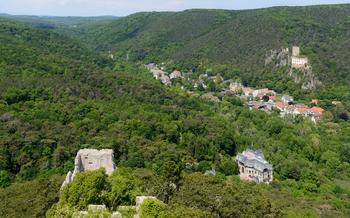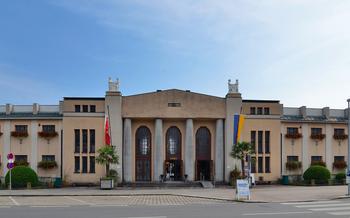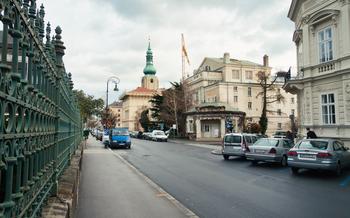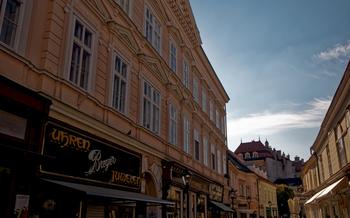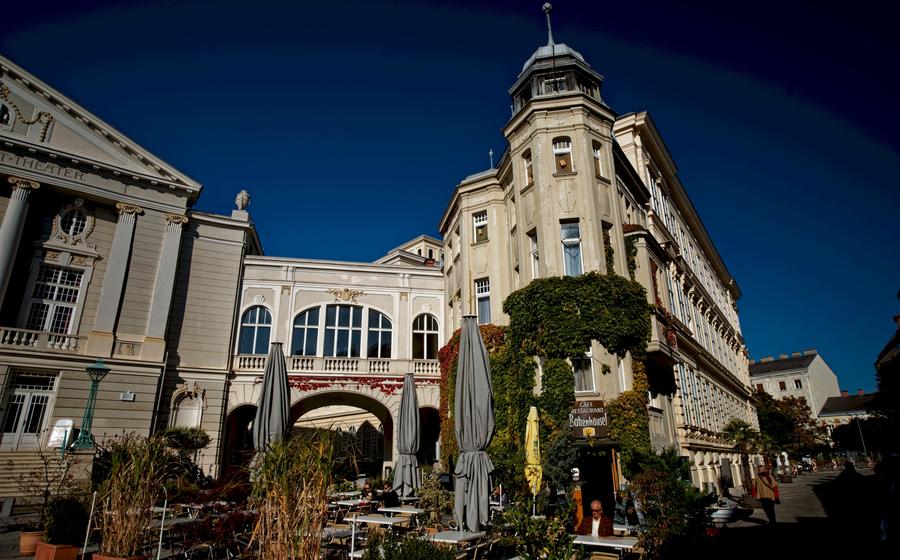
Karner (Beinhaus)
- History of the Karner (Beinhaus)
- The Ossuary
- The Cemetery
- Visiting the Karner
- Getting to the Karner
- Public transportation
- Driving directions
- Parking
- Things to Do Near the Karner
- Where to Eat Near the Karner
- Where to Stay Near the Karner
- Tips for Visiting the Karner
- What to See in the Karner
- What to Do in the Karner
- What to Buy in the Karner
- What to Eat in the Karner
- Insider Tip
History of the Karner (Beinhaus)
The Karner in Baden bei Wien, also known as the Beinhaus (Bone House), is a unique and fascinating ossuary that has captured the attention of visitors for centuries. Constructed in the late 13th century, this Gothic-style building served as a final resting place for the bones of those who perished during the numerous epidemics that ravaged the region, particularly the Black Death. Originally located outside the city walls, the Karner was later incorporated within the cemetery grounds of the Pfarrkirche St. Stephan, where it stands as a somber reminder of the fragility of life. Its architectural beauty, combined with its macabre history, makes the Karner a must-visit destination for anyone interested in history, culture, and the darker side of tourism.
The Ossuary
The Karner's ossuary is the most striking feature of the building. It is a large, vaulted chamber located beneath the chapel. The ossuary contains the bones of over 3,000 people, who were buried in the cemetery surrounding the Karner. The bones were exhumed in the 18th century and placed in the ossuary to make room for new burials.
The bones are arranged in a variety of ways. Some are stacked in neat piles, while others are arranged in patterns. There are also a number of skulls and other bones that are displayed on shelves. The ossuary is a reminder of the fragility of life and the inevitability of death. It is also a testament to the power of human memory.
The ossuary is open to the public, and it is a popular tourist attraction. Visitors can walk through the ossuary and see the bones for themselves. There is also a small museum that provides information about the history of the ossuary and the people who are buried there.
There are a number of stories and legends associated with the Karner's ossuary. One legend tells of a young woman who was buried in the ossuary. She was so beautiful that the gravedigger who buried her fell in love with her. He visited her grave every night and talked to her. One night, she appeared to him in a dream and told him that she would be his wife if he would kiss her. The gravedigger agreed, and he kissed her. The next morning, he found her body had disappeared from the ossuary.
Another legend tells of a group of thieves who tried to rob the ossuary. They were caught by the police, and they were sentenced to death. The thieves were buried in the ossuary, and their bones were used to decorate the walls.
The Karner's ossuary is a fascinating and macabre place. It is a reminder of the fragility of life and the inevitability of death. It is also a place of beauty and mystery.
The Cemetery
The cemetery surrounding the Karner is a historic and atmospheric place, with graves dating back to the 16th century. Many notable people are buried here, including the composer Ludwig van Beethoven, the poet Friedrich Schiller, and the painter Gustav Klimt. The cemetery is also home to a number of beautiful monuments and sculptures, making it a popular destination for visitors to Baden bei Wien.
The cemetery is laid out in a grid pattern, with wide paths running between the graves. The graves are mostly simple and unadorned, but there are a few more elaborate tombs and mausoleums. The most famous grave in the cemetery is that of Beethoven, which is marked by a simple headstone with his name and dates of birth and death.
The cemetery is a peaceful and reflective place, and it is a popular spot for locals and tourists alike to come and pay their respects to the dead. It is also a great place to learn about the history of Baden bei Wien and its famous residents.
Visiting the Karner
The Karner is open to the public from Tuesday to Sunday, from 10 am to 5 pm. Admission fees are €3 for adults, €2 for seniors and students, and free for children under Guided tours are available in German and English for an additional fee. The Karner is wheelchair accessible and offers a variety of facilities for visitors with disabilities, including ramps, elevators, and accessible restrooms.
To make the most of your visit, plan to spend at least an hour exploring the Karner. Take your time to admire the murals, frescoes, and stained glass windows. Descend into the ossuary to get a closer look at the bones. And be sure to wander through the cemetery, where you'll find a variety of interesting tombstones and monuments.
If you're visiting the Karner during the summer months, be sure to take advantage of the opportunity to relax in the Kurpark, a beautiful park that surrounds the Karner. The park is a great place to enjoy a picnic lunch, take a leisurely stroll, or simply relax and enjoy the scenery.
Getting to the Karner
Public transportation
Baden bei Wien is easily accessible by public transportation. The city is served by the Vienna S-Bahn (commuter rail) lines S1 and S2, which connect it to Vienna and other towns in the region. To get to the Karner, take the S1 or S2 train to the "Baden Josefsplatz" station. From there, it is a short walk to the Karner.
Driving directions
If you are driving to Baden bei Wien, take the A2 motorway and exit at "Baden". Follow the signs to the city center and park your car in one of the public parking garages or on the street. From the parking garage, it is a short walk to the Karner.
Parking
There are several public parking garages and on-street parking spaces near the Karner. The cost of parking varies depending on the location and time of day.
Things to Do Near the Karner
After visiting the Karner, there are several other attractions in the vicinity that you might want to explore.
-
Visit the Roman Baths: Just a short walk from the Karner, you can visit the Roman Baths, which date back to the 1st century AD. These well-preserved ruins offer a glimpse into the bathing culture of ancient Rome.
-
Explore the Old Town: Baden's Old Town is a charming and historic district with narrow streets, colorful buildings, and a variety of shops, restaurants, and cafés. Take a stroll through the Old Town and soak up the atmosphere of this historic city.
-
Visit the Beethoven Museum: If you're a fan of classical music, be sure to visit the Beethoven Museum, which is dedicated to the life and work of the famous composer Ludwig van Beethoven. The museum houses a collection of Beethoven's personal belongings, including his musical instruments and manuscripts.
-
Relax in the Kurpark: After a day of sightseeing, relax in the beautiful Kurpark, a large park with gardens, fountains, and walking paths. The Kurpark is a popular spot for locals and visitors alike to relax and enjoy the fresh air.
Where to Eat Near the Karner
After exploring the Karner and its surroundings, you'll probably be ready for a bite to eat. Fortunately, there are plenty of options to choose from nearby.
If you're looking for traditional Austrian cuisine, there are several restaurants in the Old Town that serve up all your favorites, such as schnitzel, Tafelspitz, and goulash. For something a little more international, there are also a number of restaurants that serve Italian, Asian, and Mediterranean food.
If you're just looking for a quick bite to eat, there are also several cafés and bars in the area where you can grab a sandwich, a pastry, or a cup of coffee.
Here are a few of our favorite restaurants near the Karner:
- Zum Gupf (traditional Austrian cuisine)
- Die Alte Post (international cuisine)
- Café Central (Viennese coffee and pastries)
- Das Loft (bar with a great selection of craft beers)
Where to Stay Near the Karner
There are many hotels, bed and breakfasts, and apartments located near the Karner. Whether you are looking for a luxurious stay or a more budget-friendly option, you will be able to find something to suit your needs.
Some of the most popular hotels near the Karner include the Hotel Sacher Baden, the Grand Hotel Sauerhof, and the Hotel am Park. These hotels offer a variety of amenities, such as swimming pools, spas, and restaurants.
If you are looking for a more affordable option, there are several bed and breakfasts and apartments located near the Karner. These accommodations typically offer basic amenities, such as a kitchen and a bathroom.
No matter where you choose to stay, you will be within walking distance of the Karner and other popular attractions in Baden bei Wien.
Here are some tips for choosing a hotel near the Karner:
- Consider your budget. Hotels in Baden bei Wien can range in price from €50 to €500 per night.
- Decide what amenities are important to you. Some hotels offer a variety of amenities, such as swimming pools, spas, and restaurants, while others offer more basic amenities.
- Choose a location that is convenient for you. The Karner is located in the center of Baden bei Wien, so it is easy to get to from anywhere in the city.
- Read reviews before you book. This will help you to get an idea of what other guests have thought of the hotel.
Tips for Visiting the Karner
- Dress respectfully: The Karner is a religious site, so it is important to dress respectfully when visiting. This means avoiding shorts, tank tops, and other revealing clothing.
- Be aware of the history of the place: The Karner is a place of death and mourning, so it is important to be respectful of the history of the place. This means being mindful of your behavior and avoiding making noise or taking photos of people who are grieving.
- Take your time to explore: The Karner is a complex and fascinating place, so it is important to take your time to explore. There is much to see and learn, so don't rush your visit.
- Take pictures, but be respectful of the dead: It is permissible to take pictures in the Karner, but it is important to be respectful of the dead. This means avoiding taking pictures of people who are grieving or of any of the bones in the ossuary.
What to See in the Karner
The Karner (Beinhaus) in Baden bei Wien is a treasure trove of artistic and historical wonders. Here's a closer look at some of the must-see features of this captivating ossuary:
-
Murals and Frescoes: The Karner's interior walls are adorned with stunning murals and frescoes depicting scenes from the Bible and the lives of saints. These vibrant paintings, created in the 14th and 15th centuries, offer a glimpse into the artistic and religious sensibilities of the medieval period.
-
Carved Stonework: The Karner's exterior is embellished with intricate carved stonework, showcasing the exceptional craftsmanship of Gothic artisans. From the delicate tracery of the windows to the intricate carvings on the buttresses, every detail exudes artistry and devotion.
-
Stained Glass Windows: The Karner's stained glass windows are a testament to the skill and artistry of medieval glassmakers. These colorful windows, depicting biblical scenes and saints, cast a warm and ethereal glow within the ossuary, creating a truly awe-inspiring atmosphere.
-
The Ossuary: Of course, no visit to the Karner would be complete without exploring the ossuary itself. Here, thousands of human bones are meticulously arranged in intricate patterns, creating a haunting and thought-provoking display. The ossuary serves as a poignant reminder of the fragility of life and the inevitability of death.
What to Do in the Karner
With its unique features and rich history, the Karner offers a variety of activities for visitors to enjoy. Here are some things you can do during your visit:
-
Take a Guided Tour: Join a guided tour to learn about the history of the Karner, its unique features, and the legends and stories associated with it. Tours are available in English and German and provide an in-depth look into the fascinating world of this historical landmark.
-
Explore the Ossuary: Descend into the ossuary to witness the impressive collection of bones, arranged in intricate patterns. Learn about the origins of the bones and the stories and legends surrounding them. The ossuary is a truly unique sight that offers a glimpse into the past.
-
Visit the Cemetery: Take a stroll through the historic cemetery surrounding the Karner. Admire the beautiful monuments and sculptures that adorn the graves, and learn about the notable people buried here. The cemetery provides a peaceful and reflective atmosphere, perfect for contemplation.
-
Relax in the Kurpark: After exploring the Karner and the cemetery, take some time to relax and rejuvenate in the nearby Kurpark. This beautiful park offers a variety of amenities, including walking paths, gardens, and a playground. It's the perfect place to unwind and enjoy the natural beauty of Baden bei Wien.
What to Buy in the Karner
The Karner (Beinhaus) in Baden bei Wien is a treasure trove of history and culture, and there is no shortage of souvenirs and mementos to commemorate your visit. In the gift shop, you can find a wide variety of items, including:
-
Books: Learn more about the history of the Karner, the ossuary, and the surrounding area with a selection of books available for purchase.
-
Postcards: Send a postcard to friends and family back home with a beautiful image of the Karner and its unique features.
-
Souvenirs: Find a variety of souvenirs to remind you of your visit, such as t-shirts, mugs, magnets, and keychains.
Whether you are looking for a gift for yourself or a loved one, you are sure to find something special in the gift shop at the Karner (Beinhaus).
What to Eat in the Karner
There are several options for dining near the Karner, catering to various culinary preferences. For a taste of traditional Austrian cuisine, try one of the many restaurants in the Old Town, such as the Gasthof zur Linde or the Kurhaus Baden. These establishments serve classic dishes like Wiener Schnitzel, Tafelspitz, and Kaiserschmarrn, accompanied by a selection of local wines and beers.
If you're looking for something different, there are several international restaurants to choose from. The Ristorante La Piazza offers authentic Italian cuisine, while the Asia Restaurant serves a variety of Asian dishes. For a quick bite or a refreshing drink, there are several cafés and bars in the area, including the Café Central and the Kurpark Café.
No matter your taste or budget, you're sure to find something to satisfy your hunger near the Karner. Be sure to sample some of the local specialties, such as the Baden rolls or the Kurbadner Torte, for a truly authentic experience.
Insider Tip
For a truly unique experience, visit the Karner at night. The Karner is illuminated at night, creating a beautiful and eerie atmosphere. The bones in the ossuary are especially striking at night, and the murals and frescoes come to life in the darkness. Visiting the Karner at night is a great way to learn about the history of the place and to experience its unique atmosphere. However, it is important to be respectful of the dead and to keep your voice down. It is also important to be aware of the fact that the Karner is a sacred place, and to behave accordingly.
